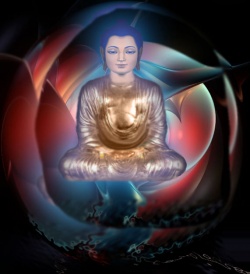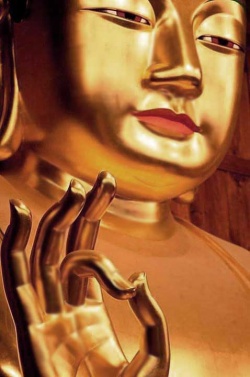Kangyur
[[Image:Buton.JPG|thumb|Butön Rinchen Drup)]
Kangyur བཀའ་འགྱུར་, Wyl. bka' 'gyur) literally the 'translated words' of the Buddha.
The Kangyur is a collection of the Buddha's own teachings in their Tibetan translation. The words of the Buddha are the sutras and the tantras.
The parent collection of the Kangyur is the Tengyur that gathers the treatises composed by the great Indian masters of the first millennium in Tibetan translation.
Though these collections aimed at exhaustiveness, most Nyingma tantras were left out by their Sarma compilers. This lead to the creation of the Nyingma Gyübum that brings together the Nyingma tantras.
The compilation of the first version of the Kangyur was finalized by the great scholar Butön Rinchen Drup (1290-1364).
Several versions of the compilation existed in Tibet, among which the most notable are those from Dergé, Lhasa, Narthang, Choné, Peking, Urga, Phudrak, and Tok Palace.
Before the compilation work started, most of the texts in these collections existed in several translations. The editors chose the one they considered the best.
While the 'chosen one' became authoritative, most of the other ones disappeared. The different editions mostly show minor variations in the texts collected.
Divisions=
Further Reading
- Paul Harrison, 'A Brief History of the Tibetan bKa' 'gyur' in Cabezón and Jackson, ed., Tibetan Literature: Studies in Genre, Snow Lion, 1996
- Peter Skilling, Translating the Buddha's Words: Some Notes on the Kanjur Translation Project, Nonthaburi, March 11, 2009
- Peter Skilling, 'Kanjur Titles and Colophons' in Tibetan Studies, vol. 2. Oslo, 1994, pp.768-780
External Links
- Tibetan Canonical Works at the TBRC
- Electronic versions of the Kangyur at asianclassics.org (ACIP)
- Online searchable Kangyur
Source
The Tibetan Buddhist canon is a loosely defined list of sacred texts recognized by various schools of Tibetan Buddhism, made up of the Kangyur or Kanjur ('The Translation of the Word') and the Tengyur or Tanjur (Tengyur) ('Translation of Treatises').
The Tibetan Buddhist Canon
In addition to earlier foundational Buddhist texts from early Buddhist schools, mostly the Sarvastivada, and Mahayana texts, the Tibetan canon includes Tantric texts.
The last category is not always sharply distinguished from the others: the tantra division sometimes includes material usually not thought of as tantric in other traditions, such as the Heart Sutra and even versions of material found in the Pali Canon.
The Tibetans did not have a formally arranged Mahayana canon and so devised their own scheme which divided texts into two broad categories, the "Words of the Buddha" and later the commentaries; respectively the Kangyur and Tengyur.
The Tengyur underwent a final compilation in the 14th Century by Bu-ston (1290–1364).
Unfortunately, we have no proof that Bu-ston also took part in the collection and edition of the Tsal pa Kangyur, but he consecrated a copy of this Kangyur 1351 as he visited Tshal Gung-thang (Eimer 1992:178).
We know from sakya mchog ldan (1428-1507) that Bu-ston edited a Kanjur; unfortunately not which one. "The Kangyur usually takes up a hundred or a hundred and eight volumes, the Tengyur two hundred and twenty-five, and the two together contain 4,569 works."
Kangyur or "Translated Words" consists of works in about 108 volumes supposed to have been spoken by the Buddha himself. All texts presumably had a Sanskrit original, although in many cases the Tibetan text was translated from Chinese or other languages.
Tengyur or "Translated Treatises" is the section to which were assigned commentaries, treatises and abhidharma works (both Mahayana and non-Mahayana).
The Tengyur contains around 3,626 texts in 224 Volumes.
The Kangyur is divided into sections on Vinaya, Perfection of Wisdom Sutras, other sutras (75% Mahayana, 25% Hinayana), and tantras.
It includes texts on the Vinaya, monastic discipline, metaphysics, the Tantras, etc. Some describe the prajñāpāramitā philosophy, others extol the virtues of the various Bodhisattvas, while others expound the Trikāya and the Ālaya-Vijñāna doctrines.
When exactly the term Kangyur was first used is not known. Collections of canonical Buddhist texts existed already in the time of Trisong Detsen, the sixth king of Tibet, in Spiti, who ruled from 755 until 797 CE.
The exact number of texts in the Kangyur is not fixed, each editor takes responsibility for removing texts he considers spurious, and adding new translations.
Currently there are about 12 available versions of the Kangyur.
These include the Derge, Lhasa, Narthang, Cone, Peking, Urga, Phudrak, and Stog Palace versions, each named after the physical location of its printing.
In addition some canonical texts have been found in Tabo Monastery and Dunhuang which provide earlier exemplars to texts found in the Kangyur.
All extant Kangyur appear to stem from the Old Narthang Monastery Kangyur. The stemma of the Kangyur have been well researched in particular by Helmut Eimer.
The Bon Kangyur
The Tibetan Bön religion also has its canon literature divided into two sections called the Kangyur and Tengyur claimed to have been translated from foreign languages but the number and contents of the collection are not yet fully known. Apparently, Bon began to take on a literary form about the time Buddhism began to enter Tibet.
The Bon Kangyur contains the revelations of Shenrab (Wylie: gShen rab, the traditional founder of Bon. A version was published in 1993-1997.


